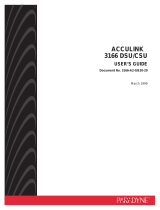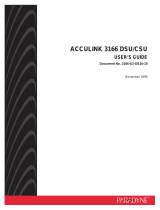Page is loading ...

You have accessed an older version of a
Paradyne product document.
Paradyne is no longer a subsidiary of
AT&T. Any reference to AT&T Paradyne is
amended to read Paradyne Corporation.

P
a
r
a
dyn
e
1
COMSPHERE 6800 Series Network Management System
SNMP Trap Export Feature
Feature Number 6801-C4-020
Installation and Enabling/Disabling Instructions
Document Number 6800-A2-GZ45-00
April 1994
Overview
The 6800 Series Network Management System (NMS) SNMP (Simple Network Management Protocol) Trap
Export feature enhances the interoperability between the 6800 Series NMS and most industry-standard,
SNMP-based network management systems. This feature exports native 6800 Series NMS alerts as standard
SNMP traps. All traps are generated as enterprise specific.
Variable Bindings Information
The 6800 Series NMS alert information is packed into the variable bindings. The fields from the Common
Alert Format of the 6800 Series NMS that are put into the variable bindings are the following:
• Device Type
• Device Address
• Alert Type
• Alert Text
Each of these fields is handled as a separate MIB (Management Information Base) variable. (The entire MIB
definition is registered formally.) These SNMP alerts are forwarded on the TCP/IP network. In this context, the
term TCP/IP network refers to the entire internet suite of protocols. Traps can be forwarded to any specified
SNMP Manager on the network. The SNMP Manager may require a formal definition of the variable bindings
to be parsed into its MIB definitions. Also, users must specify the internet address of the SNMP Manager on the
6800 Series NMS host. Both of these requirements are discussed in the installation instructions provided in this
document. The traps community string will always be public.
Object Identifier
The SNMP traps forwarded from the 6800 Series NMS contain a single object identifier, the 6800 NMS, which
is registered under the att-management sub-tree. The fully distinguished name for this object is the following:
iso(1).identified-organization(3).dod(6).internet(1).private(4).enterprise(1).att-2(74).att-mgmt(2).paradyneNMS(23)

2
User Features
For users requiring the flexibility to turn trap forwarding on and off and to provide a more customized filtering
mechanism for traps, the following user features are provided.
• User facility to turn the trap forwarding on/off.
• Forwarding ability for selected alerts using the UAI (Uniform Alarm Interface) Filter; that is, any new
alerts passing the UAI filter are forwarded as an SNMP trap. Existing alerts will not be forwarded on
start-up. Alert clears and alert updates will never be sent.
• Ability to view alerts on the SNMP Manager from the X-workstation. Refer to the COMSPHERE
6800 Series Network Management System User’s/System Administrator’s Guide, Appendix I, for more
information on X-window cut-through for the SNMP Manager and the COMSPHERE 6800 Series
Network Management System Installation and Maintenance Guide for more information on connecting
the components.
NOTE
In the device profile, the ability to turn the forwarding mechanism
within UAI on/off is not supported for SNMP traps. That is, alerts for
SNMP will always be sent at the device level.
Network Interface
The SNMP Trap Export feature assumes that the SNMP Manager is connected to the 6800 Series NMS via the
TCP/IP network. There is no limitation on the physical medium. It could be Ethernet, which is the most
commonly used physical interface. The SNMP trap forwarding server will use the Transport Layer Interface
(TLI) to access the network services. It will use the User Datagram Protocol (UDP) as the transport layer. This
is a connection-less service without guaranteed delivery. This is the standard requirement for all SNMP PDUs
(Protocol Data Units).
Installation Notes
The SNMP Trap Export feature is contained on three diskettes:
1. NMS 6800 install diskette
2. DOS MIB diskette
3. UNIX MIB diskette
The first diskette contains the install script which enables the trap forwarding server. The remaining diskettes
provide the variable binding MIB definition, one for UNIX and the other for DOS. Typically, any two of these
three diskettes are used during installation. The installation must be done in the super-user mode. Hence, before
starting the installation, you must login as root and change the directory to /tmp.
After installing the software, you must enable the feature using the trpEnable command described later in this
document. This document describes the TrpDisable command for disabling the feature as well.

3
Installation and User Commands
This section provides installation instructions and descriptions of the commands for enabling and disabling the
trap forwarding feature. The installation procedure must be used by both new users and users upgrading their
system with the trap forwarding feature. New users must install the 6800 Series NMS before installing this
feature. The required base version of the 6800 Series NMS must be Release 4.1 or greater installed with
PTF 4.1.1 or greater.
The enable and disable commands can be run from the system command line. You must restart the 6800 Series
NMS each time this feature is either enabled or disabled.
Installing Trap Forwarding
NOTE
It is recommended that you shut down the 6800 Series NMS before
starting this installation process. Refer to the
COMSPHERE
6800 Series Network Management System User’s/System
Administrator’s Guide
for this procedure.
To install the trap forwarding feature, use the following steps:
1. Login as root.
2. Insert the install diskette into the floppy diskette drive on the host.
3. At the UNIX prompt:
TYPE: cd /tmp
tar –xvf /dev/fd0
/tmp/trpInstall
4. (OPTIONAL STEP). Enable the SNMP Trap Export feature to initiate trap forwarding during feature
installation. Refer to Enabling Trap Forwarding later in this document. To defer enabling this feature to
a later time, ignore this step.
5. (OPTIONAL STEP). Restart the 6800 Series NMS. You must restart the NMS for the trap forwarding
feature to be in effect to send the traps to the node whose internet address was specified during the
feature enable step. The procedure for observing traps on the SNMP Manager is documented in your
SNMP Manager documentation.

4
6. Install the appropriate MIB software on the SNMP Manager. Use one of the following command lines,
depending on whether the concerned SNMP Manager is DOS-based or UNIX-based, to copy the file
from the floppy diskette onto the machine running the SNMP Manager. Then, refer to your SNMP
Manager documentation for details on how a MIB module definition in ASN.1 can be parsed into the
internal data representation of the concerned SNMP Manager.
• For DOS-based SNMP Managers:
a. Insert the DOS MIB diskette into the machine running the SNMP Manager.
b. At the DOS prompt:
TYPE: copy <drive specification>:nms.asn C:
Where: <drive specification> is the floppy drive containing the diskette and nms.asn is
the name of the MIB file which will be copied into the root directory of the C:
drive.
• For UNIX-based SNMP Managers:
a. Insert the UNIX MIB diskette into the machine running the SNMP Manager.
b. At the UNIX prompt:
TYPE: tar-xvf /dev/fd0 (current directory needs to be writeable)
7. Use the ping command to confirm that the SNMP Manager can communicate with the 6800 Series
NMS host. A positive echo from this command confirms that the SNMP Manager is responding. If an
error message(s) appears, the TCP/IP connectivity must be debugged. You can refer to the ALTOS
TCP/IP documentation for the appropriate procedures.
Enabling Trap Forwarding
Use the following steps to enable trap forwarding if the feature package is already installed. If you are enabling
the feature during installation, use Steps 2 and 3 only.
NOTE
The trpEnable command must be executed every time an installation or
de-installation is performed. Once the 6800 Series NMS is shutdown, the
installation or de-installation can be done. After the installation or
de-installation is completed, execute the trpEnable command and then
restart the 6800 Series NMS.
1. Shutdown the 6800 Series NMS. Refer to the COMSPHERE 6800 Series Network Management System
User’s/System Administrator’s Guide for this procedure. Although this step is not required, it is strongly
recommended.
2. Login as a super-user.
3. At the super-user prompt:
TYPE: /usr/nms/RNMS/bin/Platform/trpEnable.

5
This command will prompt the user for a destination host for the traps. At the prompt enter the internet
address of the node on which the SNMP Manager is installed. The internet address must be entered in
standard notation (e.g., 135.20.40.6).
NOTE
You must avoid causing an infinite loop consisting of traps being
forwarded back to the host that is sending them. You can cause these
loopbacks either directly by forwarding traps back to the local host
(making the
ip_address
the address of the local host) or indirectly by
forwarding traps to another host that is already forwarding traps to the
local host.
4. Restart the 6800 Series NMS. This step is required to enable trap forwarding. The traps will be
forwarded to the node specified by the internet address in the previous step. Refer to your SNMP
Manager documentation for the procedure for observing traps on the SNMP Manager.
Disabling Trap Forwarding
Use the following steps to disable trap forwarding.
1. Shutdown the 6800 Series NMS. Refer to the COMSPHERE 6800 Series Network Management System
User’s/System Administrator’s Guide
for this procedure. Although this step is not required, it is strongly
recommended.
2. Login as a super-user.
3. At the super-user prompt:
TYPE: /usr/nms/RNMS/bin/Platform/trpDisable
4. Restart the 6800 Series NMS. This step is required to disable trap forwarding. Once the 6800 Series
NMS is restarted, NMS 6800 traps will not be forwarded to the SNMP Manager.

6
MIB Definition
The following listing describes the MIB definitions. The language used for the MIB definition is the industry-
standard ASN.1 (Abstract Syntex Notation). The macros used for the MIB definitions are defined in the
Structure of Management Information, RFC (Request For Comments) 1155. The defined objects are assigned
object identifiers and are registered appropriately. There are four objects packed into the variable bindings. The
following listing shows the definitions of these four objects.
__________________________________________________________________________________________
NMS6800–MIB{isoorg(3)dod(6)internet(1)private(4)enterprises(1)att–2(74)att–mgmt(2) }
DEFINITIONS ::= BEGIN
IMPORTS
enterprises, OBJECT–TYPE, NetworkAddress, IpAddress, Gauge, TimeTicks
FROM RFC1155–SMI;
att–2 OBJECT IDENTIFIER ::= { enterprises 74 }
att–mgmt OBJECT IDENTIFIER ::= { att–2 2 }
paradyneNMS OBJECT IDENTIFIER ::= { att–mgmt 23 }
deviceType OBJECT–TYPE
SYNTAX DisplayString
ACCESS read–write
STATUS mandatory
::= { paradyneNMS 1 }
deviceId OBJECT–TYPE
SYNTAX DisplayString
ACCESS read–write
STATUS mandatory
::= { paradyneNMS 2 }
alertType OBJECT–TYPE
SYNTAX DisplayString
ACCESS read–write
STATUS mandatory
::= { paradyneNMS 3 }
alertDesc OBJECT–TYPE
SYNTAX DisplayString
ACCESS read–write
STATUS mandatory
::= { paradyneNMS 4 }
END;
_______________________________________________________________________________________________
/









